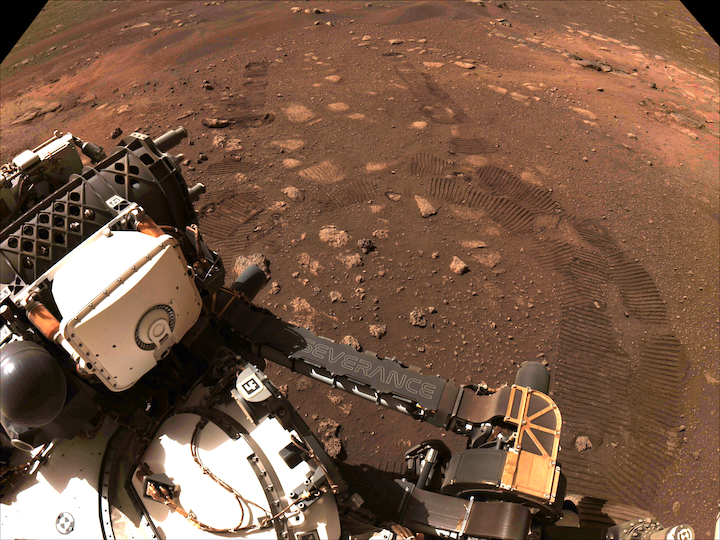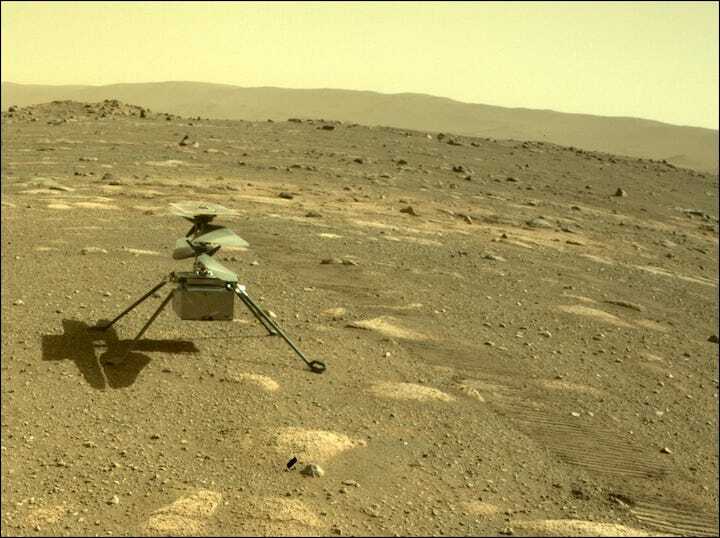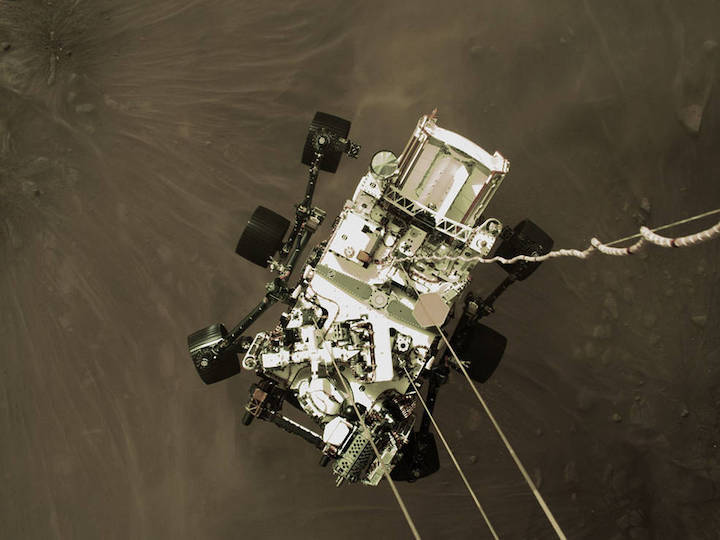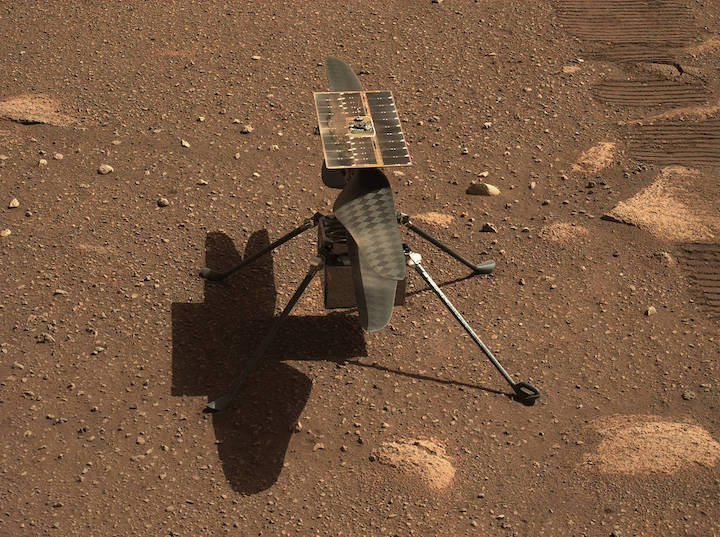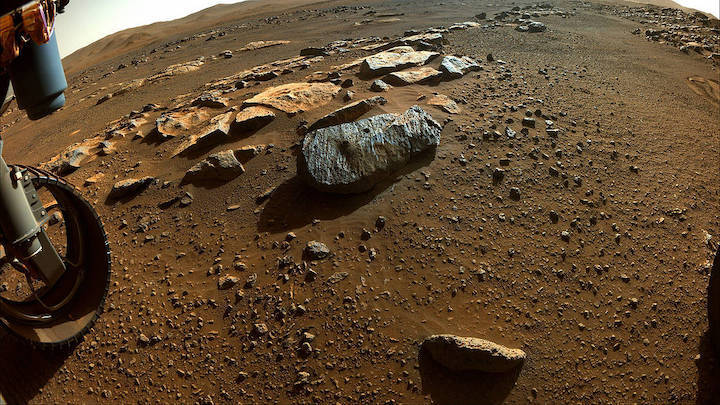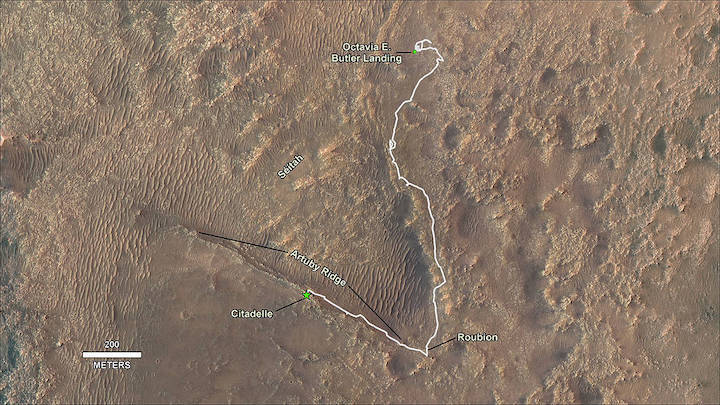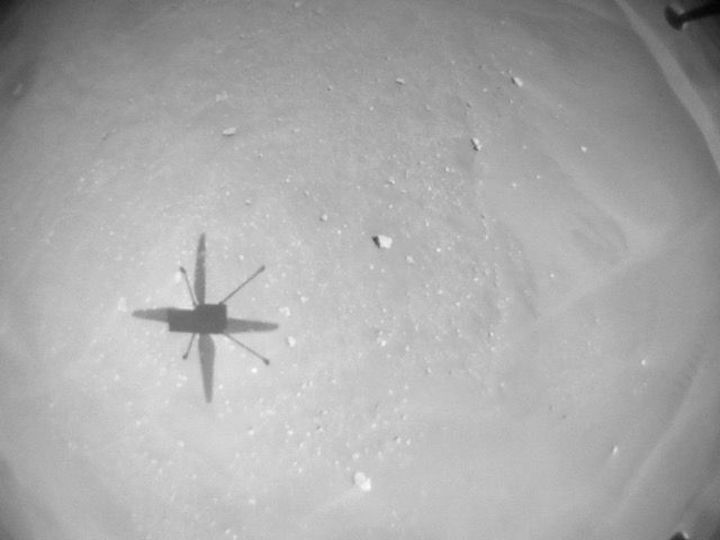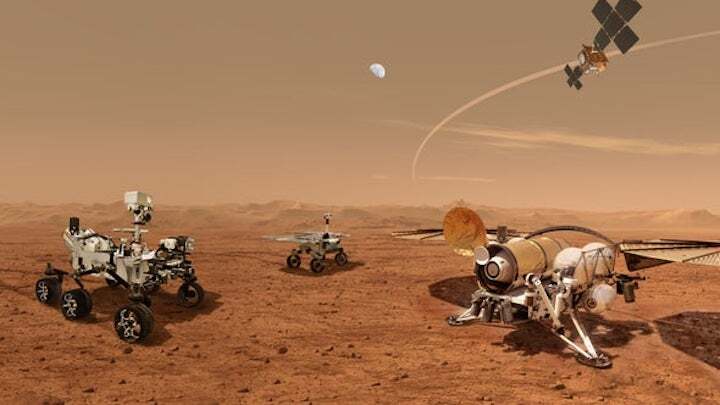Within a decade, a small rover on Mars will pick up samples of rock left by a previous mission. It will then load them into a rocket secured within a small platform on a flat patch of the planet’s surface. Once the rocket’s hatch has closed, the platform will toss it upward on its side, a bit like a thrown American football. The rocket’s engines will ignite, propelling it into Martian orbit—where a waiting spacecraft will grab its invaluable samples for ferrying back to Earth and into the hands of researchers eager to study them for signs of past life on the Red Planet. One might call this wild interplanetary shuffle the most epic game of catch ever conceived, but scientists simply refer to it as Mars Sample Return.
“It’s never been done before,” says Chris Chatellier of NASA’s Jet Propulsion Laboratory (JPL), lead engineer of part of the launch system that will bring the samples back home. But it has been dreamed of—and planned—for decades.
The first step occurred with the landing of NASA’s Perseverance rover in Jezero Crater on Mars one year ago to explore the site’s eons-old river delta, targeted as one of the most likely locales to harbor any remnants of life from when the planet was a warmer, wetter world. Using an extendable arm and drill inside the crater, Perseverance has started collecting samples that likely date back billions of years. “We believe the samples will tell us whether there used to be life at the surface of Mars,” says NASA’s Thomas Zurbuchen, who oversees the space agency’s science missions. Ultimately Perseverance will place dozens of samples in small cigarlike tubes, caching them on the surface to await future collection.
The general outline for how this collection will take place is already clear, but key details remain undetermined. For example, where—and in how many locations—will the samples be cached? What will the “fetch rover” that will collect them—to be built by the European Space Agency (ESA)—look like? And perhaps most crucially, how will the samples successfully rocket off the surface of Mars and back to Earth? “This launch off another planet will be history-making,” Zurbuchen says. “With it comes answers to our neighboring planet that cannot otherwise be addressed.”
The details on that crucial last question have now moved a significant step forward. Last month NASA selected the U.S. aerospace firm Lockheed Martin for a potentially $194-million contract to build the three-meter-long Mars Ascent Vehicle (MAV), a relatively small rocket meant to propel Perseverance’s samples into orbit. Already, engineers are hard at work designing the MAV’s components, which must overcome multiple challenges unique to this first-of-its-kind mission. The Red Planet’s gravity, while only a third of Earth’s, must be overcome. Mars’s thin atmosphere, 100 times as tenuous as Earth’s, will make the launch unlike any on our planet—or from the airless moon or asteroids, where previous successful sample-returns have taken place. And the MAV’s all-or-nothing launch, millions of kilometers from Earth, must be both autonomous and flawless.
A video featuring prototype testing for NASA’s Mars Ascent Vehicle launch system and several other key components for returning samples from the Martian surface.
NASA says the MAV will launch to Mars in 2026 or later, and some have forecasted that the likely date will be 2028. It will be stored inside a landing platform not unlike those of predecessors such as NASA’s InSight lander. InSight touched down on Mars in 2018, performing a propulsive landing rather than relying on the more complex Sky Crane systemrequired for the heavier Perseverance rover and its kin, Curiosity. The journey to Mars will be slow, 28 months in all, to ensure that the MAV touches down during local summer in or near Jezero. “The spacecraft needs to arrive at the proper season at Mars so that it doesn’t encounter dust storms,” says Dave Murrow, Lockheed Martin’s business development lead for deep space exploration.
After safely passing through the atmosphere, the lander will aim to land within a region of the crater that is as benign as possible in order to facilitate an easier subsequent liftoff. “We’ll be looking for a nice, flat landing site without many rocks,” Murrow says. The actual site will be selected in the coming years. The lander, devoid of scientific instrumentation, will be designed to protect the MAV on the surface, deploy ESA’s fetch rover and finally launch the sample-filled MAV back to orbit.
One major challenge will be ensuring that the aluminum-based fuel used by the MAV’s propulsion systems, provided by the U.S. aerospace company Northrop Grumman, does not freeze. Temperatures on the Martian surface average about –60 degrees Celsius, so the lander will need to warm the MAV, likely by using solar-powered electric heaters inside an insulated canister aptly called an “igloo.” This approach, engineers believe, should allow the MAV to linger on the surface for up to one Earth year, hopefully offering sufficient time for the fetch rover to retrieve Perseverance’s samples from one or more surface caches.
Then the real fun begins. Over the past few years, Chatellier and his team at JPL have been grappling with the surprisingly hard problem of how, exactly, to launch a small rocket from Mars. “We started with the basic idea of pointing [the MAV] on a rail and launching it off a platform,” Chatellier says. But the rail would need to be heavy and almost as long as the lander itself. “The concern was there’s not a lot holding the lander down,” says Angela Jackman, project manager of the MAV program at NASA’s Marshall Space Flight Center. Without the counterweight of a heavy rail, the exhaust plume from the launching MAV could kick the entire platform up into the air to strike the rocket. Earthbound testing of such a system in simulated Mars-like gravity and atmospheric conditions would also be very challenging.
So the team instead settled on another idea: What if the rocket could be tossed several meters above the surface, allowing more clearance for blastoff? “Although it might seem counterintuitive to throw up an unlit rocket, it actually does simplify the design and test process quite a bit,” Chatellier says. Such a “cold launch” system is not unprecedented: the U.S. Air Force’s Peacekeeper missiles, in service from 1987 to 2005, were lofted out of silos using steam pressure before their engines were ignited. The approach for MAV is also similar to a standard missile launch from a fighter jet, except “we’re just throwing it up off the ground,” Chatellier says.
The result is a launch system called VECTOR, or Vertically Ejected Controlled Tip-Off Release. For the past two years the JPL team has been testing a mock-up of the MAV with VECTOR, completing 23 “throws” in total so far, with cables catching the rocket in midair. (The system in its entirety, including the ignition of the rocket, will only be fully used for the first time on Mars.) VECTOR is designed to hurl the MAV skyward from Mars at about five meters per second using a force comparable to a strong human punch. As the MAV ignites its engine, one second post-toss, VECTOR will also help aim the craft, causing a rotation that tilts it up by 45 degrees from a horizontal orientation midair to allow the MAV’s two-stage rocket to propel the basketball-sized sample capsule to a 400-kilometer-high orbit above the planet. With any luck, Perseverance will still be operational and watching from a safe distance away, offering everyone back on Earth a virtual front-row seat for this first-ever Martian launch.
If all goes well, shortly thereafter a European-built spacecraft will swoop in to scoop up the sample capsule in Martian orbit, stowing it for the journey home. After departing from Mars, the capsule will purposefully crash land in the Utah desert in the early 2030s with its durable samples intact.
Audacious as it may be, VECTOR appears to be the best way to get the half-kilogram’s worth of samples Perseverance will collect back to Earth. “Everyone thought Sky Crane was crazy,” Chatellier says. “VECTOR has drawn similarities to that.” In the coming years he and his team hope to have completed about 50 tests of system so that it will be ready for launch to Mars in 2028. There are still other details to be worked out, including the finer mechanics of how the rocket will be hurled aloft, but the goal is to have a system that can cope with whatever conditions Mars throws at it. There will be no second chances. “We want to make sure we have a robust design so that, even on the worst possible day on Mars, we know the system is still going to work,” Chatellier says.
The dream of Mars Sample Return is now on the cusp of becoming reality, perhaps scarcely a decade away, aided by a deceptively simple idea: land a small rocket on Mars, toss it into the thin, cold air and launch it back to space. Even if the materials it ultimately helps return show no signs of life, the result will be no less historic. “We nerd out all the time on this,” Jackman says. “What we’re going to do is just amazing.”
Perseverance will grab one more sample from its current site and then head toward an ancient river delta.
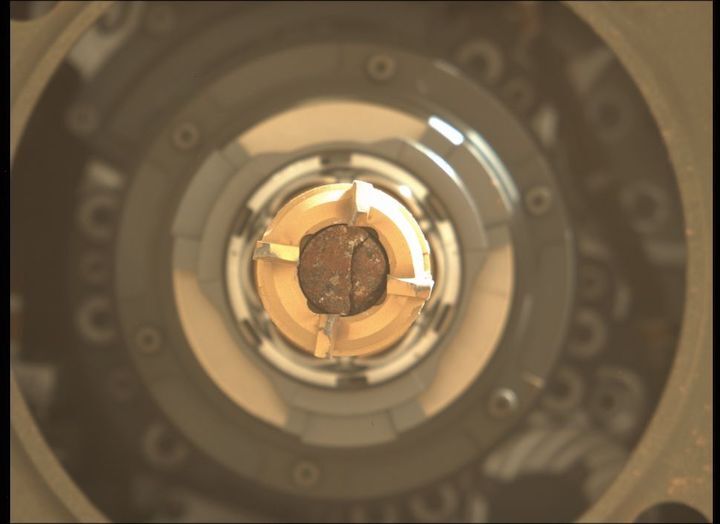
NASA's Mars rover Perseverance rover has collected its seventh Red Planet rock sample, seen here in a photo taken on March 7, 2022. (Image credit: NASA/JPL-Caltech/ASU)
NASA's Perseverance rover now has seven Mars rock samples in its collection.
The car-sized robot drilled into another Martian rock and socked away the resulting core, mission team members announced via Twitter today (March 8). It's the seventh drilled sample that Perseverance has collected since touching down on the floor of the Red Planet's Jezero Crater in February 2021.
Collecting samples for future return to Earth is one of Perseverance's two main tasks, along with hunting for signs of ancient Mars life. The 28-mile-wide (45 kilometers) Jezero harbored a lake and a river delta in the ancient past, so it's a great place to do such work, mission team members have said.
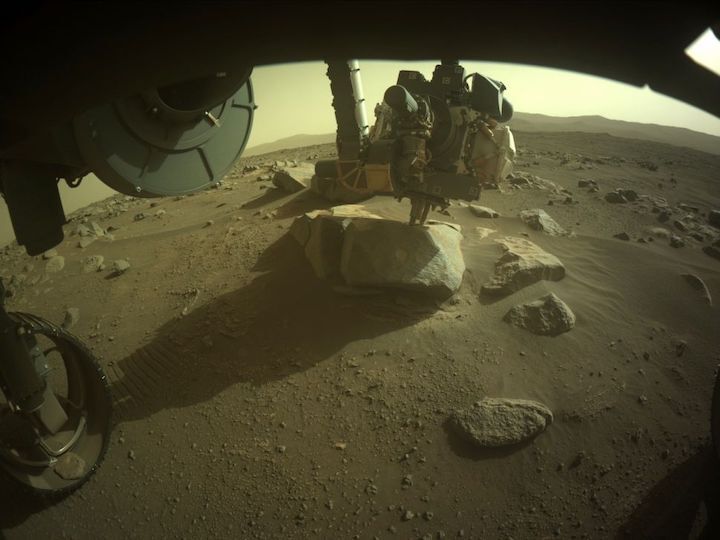
NASA's Mars rover Perseverance just collected its seventh Red Planet rock sample. This photo shows the rover in action on March 7, 2022. (Image credit: NASA/JPL-Caltech)
Here on Earth, river deltas are good at preserving signs of life as we know it, as well as life's basic building blocks, carbon-containing organic compounds. Perseverance team members are therefore eager to explore remnants of the Jezero delta, and they plan to do so soon.
"I plan to get one more sample here before heading on toward the ancient river delta," the rover team said in today's tweet, assuming the voice of Perseverance (as they tend to do with this account).
Perseverance spent its first (Earth) year on Mars exploring the crater floor to the south and west of its landing site, which was named after sci-fi author Octavia Butler. The rover is now heading back toward the touchdown zone, on its way to an accessible segment of the ancient delta.
The Perseverance team is planning the rover's route with the help of Ingenuity, the 4-pound (1.8 kilograms) helicopter that landed with Perseverance last year. Ingenuity aced its original mission, a five-flight technology-demonstrating campaign, and is now scouting terrain for the rover on an extended mission. Ingenuity has flown 20 times on Mars to date and is still going strong.
If all goes according to plan, Perseverance will end up collecting and caching several dozen Red Planet samples. This material will be brought to Earth, perhaps as early as 2031, by a joint NASA-European Space Agency mission campaign.
Quelle: SC
----
Update: 11.03.2022
.
Mars rover wraps survey of Jezero crater’s surprising volcanic floor
After collecting eight rock cores, Perseverance will zip toward fossilized delta

THE WOODLANDS, TEXAS—After a year exploring the floor of Mars’s Jezero crater, where it gathered seven—soon to be eight—chalk-size rock samples for return to Earth, NASA’s Perseverance rover is set to speed toward its longstanding target at the crater’s edge: the remnants of a delta, deposited by water billions of years ago, that may contain fossilized evidence for past life.
Since the $2.7 billion rover landed in February 2021, it has traveled nearly 5 kilometers, following the boundary of two distinct sets of rocks on the crater floor, called Máaz and Séítah, before retracing its steps back to its landing site, where this week it collected its seventh rock sample.
The journey yielded surprises, the rover team announced this week here at the Lunar and Planetary Science Conference (LPSC). One is that none of the rocks seen so far were deposited by water, despite clear evidence that Jezero once hosted a deep lake, said Vivian Sun, a planetary scientist at NASA’s Jet Propulsion Lab (JPL), who helped lead the crater-floor campaign. “We now know that the crater floor rocks, both Máaz and Séítah, are igneous in origin.”
That’s a welcome finding, as dates gleaned from the volcanic rocks could reveal when the later flood of water filled the crater. And it doesn’t dim hopes for finding ancient life in the crater. Even if the rocks weren’t deposited by water, the team is finding that they interacted with it, creating a decent home for life.
Data gathered from spacecraft in orbit around Mars already hinted that Jezero crater contained volcanic rocks. But on Mars, many lake-deposited sediments were eroded from igneous rocks and can appear volcanic from space. Soon after landing, Perseverance spotted layering in Séítah rocks that, at first blush, made them seem sedimentary. But once the rover inspected the rocks and used spectrometers mounted on its robotic arm to analyze their composition, it saw the hallmarks of molten formation. Séítah rocks contained evenly distributed crystals of the mineral olivine, which coalesce as magma slowly cools, whereas Máaz rocks had small grains of pyroxene and plagioclase, interlocked in a way that indicated igneous formation.
During most of its drive, Perseverance has stuck to Máaz, because Séítah is covered with impassable sand dunes. Halfway through its tour, though, the rover ducked into Séítah between dunes, guided by the reconnaissance of the Ingenuity helicopter, to drill several samples. (Ingenuity has flown 20 times so far, and it is now flying ahead to continue scouting for the rover at the delta front.) Observations from the rover’s cameras and ground-penetrating radar showed that the Séítah rocks underlie Máaz, which in turn lies under the delta formation, much of which has since eroded away from the crater floor.
The mostly likely explanation for this layering is that Séítah is the eroded remnant of an underground magma chamber, Linda Kah, a planetary scientist at the University of Tennessee, Knoxville, said at LPSC. Orbital pictures suggest later eruptions formed Máaz, said Briony Horgan, a planetary scientist at Purdue University. “We do think it is probably a lava flow.”
These volcanic rocks promise an eventual bonanza once the samples are returned to Earth in a mission later this decade, because their formation can be dated from the radioactively decaying elements they contain. Dates would bound the timing of the water that eventually came to Jezero crater, and help calibrate a system for dating other craters on Mars and elsewhere in the inner Solar System. “There will be a really interesting geochronology story,” Horgan said.
Despite their volcanic origin, the crater floor rocks show signs of modest alteration by water, and some could have provided a happy home for past microbial life, according to work presented at LPSC by Eva Scheller, a geologist at the California Institute of Technology. By firing an ultraviolet laser into the water-formed carbonate minerals in a Séítah rock, the SHERLOC spectrometer detected the distinctive fluorescence of simple ring-shaped organic compounds—a hint that even more complex organic molecules could have developed in the wet sediments. There is a “striking resemblance” to martian meteorites like Allan Hills 84001, famed for its abiotically formed organic molecules, Scheller said. “This could potentially be a habitable environment.”
After the Perseverance team drills an eighth sample near the landing site this week, the rover will skirt past Séítah’s dunes to reach the foot of the delta at a place they’ve dubbed Hawksbill Gap. The team will have to work fast, as it committed to collecting some 20 samples during the first 2 years, from not just the delta but the crater rim beyond, which is marked by a “bathtub ring” of carbonates reminiscent of those deposited by microbial mats along earthly shores. These samples will then be deposited in a cache on the surface for retrieval by the subsequent mission.
Thanks to improved autonomous driving capabilities, the rover can travel more than 300 meters in a day, several times farther than its still-operating predecessor, the Curiosity rover. Perseverance will likely reach the delta front by April, said Sanjeev Gupta, a geologist at Imperial College London. By then, he added, “Everything I’m telling you could be wrong.”
Using the zoom camera mounted on the rover’s mast, Gupta and his colleagues have scouted ahead and observed a clear layering at Hawksbill that indicate it formed in water that was once 45 meters deep. The bottommost layers are likely where the finest sediments accumulated—a perfect hunting ground for signs of past life.
Quelle: AAAS
----
Update: 13.03.2022
.
Mars helicopter Ingenuity aces 21st Red Planet flight
Flight 21 is in the books.

NASA's Ingenuity Mars helicopter conducts its 13th Red Planet flight, on Sept. 4, 2021, in this image captured by NASA’s Perseverance rover. Ingenuity just aced its 21st Mars sortie, NASA officials announced on March 11, 2022. (Photos from the flight were not immediately available.) (Image credit: NASA/JPL-Caltech/ASU/MSSS)
The Ingenuity helicopter's Red Planet flight tally is up to 21.
The 4-pound (1.8 kilograms) NASA chopper just aced another Mars sortie, agency officials announced today (March 11).
"#MarsHelicopter can’t be stopped! Ingenuity successfully completed its 21st flight on the Red Planet. The small rotorcraft traveled 370 meters [1,214 feet] at a speed of 3.85 meters per second [8.61 mph] and stayed aloft for 129.2 seconds," NASA's Jet Propulsion Laboratory (JPL), which manages Ingenuity's mission, said via Twitter today.
In February 2021, Ingenuity landed with NASA's Perseverance rover on the floor of Mars' Jezero Crater, which hosted a lake and a river delta billions of years ago. The solar-powered helicopter initially embarked upon a five-flight demonstration mission designed to show that aerial exploration is feasible on Mars despite the planet's thin atmosphere. (Mars' air is just 1% as thick as that of Earth at sea level.)
Ingenuity aced those five flights, and NASA soon granted a mission extension. During this phase, the rotorcraft has been pushing the boundaries of Red Planet flight and serving as a scout for Perseverance, whose main tasks involve hunting for signs of Mars life and collecting dozens of samples for future return to Earth.
During their first year on Mars, Ingenuity and Perseverance explored areas to the south and southwest of their landing site. Both robots are now heading back toward their touchdown zone, on the way to an accessible part of the ancient river delta.
The Perseverance team is eager to start studying the delta up close, because deltas here on Earth are good at preserving carbon-containing organic chemicals and signs of life itself.
During its 21 Martian flights, Ingenuity has stayed aloft for a total of 38.8 minutes and traveled 15,246 feet (2.89 miles; 4.65 kilometers). That's more ground than Perseverance has covered on Mars; the rover's odometer currently reads 2.73 miles (4.39 km).
Quelle: SC
----
Update: 14.03.2022
.
Ingenuity still “as good as new” after nearly a year on Mars
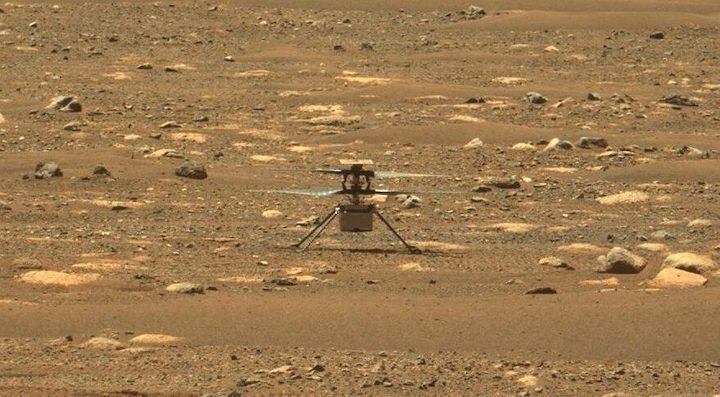
Ingenuity, originally developed as a tech demo with a goal of up to five flights, has now flown 21 times and serves as a scout for the Perseverance rover. Credit: NASA/JPL-Caltech/ASU/MSSS
WASHINGTON — After nearly a year of operations, NASA’s Ingenuity Mars helicopter is still “as good as new” as it serves as a scout for the Perseverance rover.
NASA’s Jet Propulsion Laboratory announced March 11 that Ingenuity completed its 21st flight on the planet, traveling 370 meters during the 129-second flight. The helicopter has now traveled more than 4.6 kilometers since its first flight in April 2021.
Ingenuity was developed as a technology demonstration, with an original plan of no more than five flights over a month. The excellent performance of the 1.8-kilogram helicopter, though, led NASA to extend its mission, using it as a scout to examine terrain ahead of the Perseverance rover that carried Ingenuity to Mars.
The information Ingenuity has provided has created some modest time savings for Perseverance. “It’s certainly shaved several sols, maybe a week, off of the time frame of the rover by having this advanced information,” said Matt Golombek, a senior research scientist at JPL who has been involved with Mars landers dating back to Mars Pathfinder, during a March 8 media briefing at the Lunar and Planetary Sciences Conference. A sol is a Martian day, about 40 minutes longer than a terrestrial day.
Other scientists involved with Perseverance agreed that Ingenuity has been useful. “I was really impressed with how well it worked and how useful it’s been,” said Justin Simon, a planetary scientist at NASA’s Johnson Space Center who works on the Perseverance mission, during a conference session March 7. “I don’t think that was fully anticipated, at least by myself.”
Keyron Hickman-Lewis of the U.K.’s Natural History Museum, another Perseverance scientist, said at that conference session that Ingenuity has been particularly helpful as Perseverance negotiated a region called Séítah. “The terrain is not optimal for a rover,” he said of the region. “These insights have been invaluable.”
That work will continue as Perseverance heads in the coming weeks to the remnants of a river delta. “The intent is to keep the helicopter out in front of the rover to provide advance information that would help in its exploration,” Golombek said. That includes scouting paths the rover could take into the delta and identifying rocks for the rover to study with its instrument suite.
Ingenuity itself has shown no signs of wear and tear after nearly a year of flying on Mars. “So far, we have found no degradation or loss of anything on the helicopter. It is as good as new,” he said.
The helicopter, which uses solar power, also has no consumables to limit its life. “There’s nothing consumable and nothing to stop us from continuing to operate as long as the helicopter remains healthy,” he said, with the expectation Ingenuity will continue operations until something finally breaks.
That performance is all the more noteworthy, he added, because of the use of commercial off-the-shelf parts that had been previously qualified for space on Ingenuity, rather than customized components. “It is rather remarkable that we’ve had no degradation or loss of any aspect of the helicopter,” he said.
Golombek said the performance of Ingenuity demonstrates how useful such helicopters could be in future exploration, although NASA has no firm plans currently for additional helicopter missions. “The idea of a technology demo is to demonstrate that here is a new way to explore Mars,” he said. “Ingenuity has shown the promise of this sort of way to continue our exploration of the red planet.”
Quelle: SN
----
Update: 16.03.2022
.
Mars helicopter’s odyssey
Originally deployed as something of an experimental novelty, the Mars Ingenuity helicopter has proved to be both useful and durable.
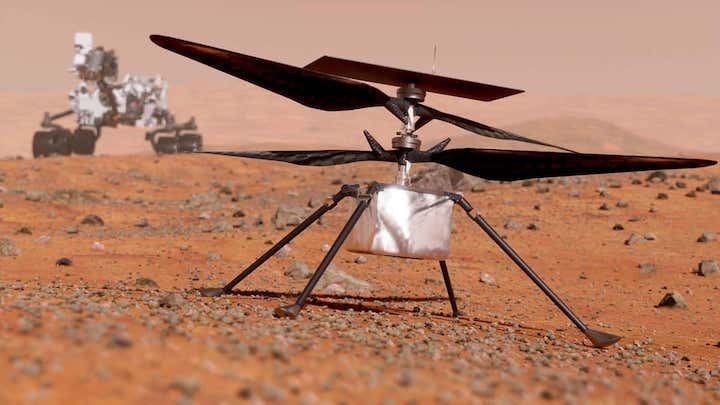
year and 20-plus flights into what was supposed to be a one-month mission, NASA’s Ingenuity helicopter is not only still going strong, but has evolved into a valuable companion for the Perseverance Mars rover.
The 1.8-kilogram helicopter was designed as a technology demonstration – simply to find out if it is indeed possible to fly on Mars. But when Perseverance set off on the first phase of its mission – a one-year-exploration of the rocks forming the floor of its landing site in Jezero Crater, scientists and engineers scrambled to find ways to make the helicopter useful.
A big part of what was needed, says Matt Golombek, a planetary geologist at NASA’s Jet Propulsion Laboratory (JPL), in California, was to find a way to increase the helicopter’s range – not by somehow beefing up its battery; that’s clearly impossible – but by increasing how far it could safely advance in any given flight.
In its initial tests, the helicopter would fly out from one landing site to scout for possible new places to land, then return to its original site and wait for the flight team to examine the images it collected to decide where it could safely land. It would then hop to the new landing site and prepare to start the process anew.
It was a very safe process, but it was also cumbersome. “We quickly figured out that if we had to scout out every site before we landed, we would dramatically restrict operations,” Golombek said last week at the 2022 Lunar and Planetary Science Conference in The Woodlands, Texas. In fact, there were concerns that the helicopter would eventually get outrun by the rover and have to be abandoned.
What was needed was a way to find safe landing zones from space, so the helicopter could go directly from one to another without flying back and forth. Eliminating the need to do that would also double the distance it could go – an important factor because its maximum flying time between battery recharges is a little less than three minutes.
Doing that from space was tricky, however, because the tiniest rocks that could be spotted in high-resolution satellite images were 25 centimetres across, and for the tiny helicopter, a 25cm rock was plenty big enough to be a hazard.
Sussing out safe landing zones from space, however is something Golombek has been doing for a quarter of a century, ever since the Mars Pathfinder landing in 1997. “My day job is selecting landing sites on Mars,” he says, “so I’ve spent most of my career looking for rocks.”
And while spacecraft the size of Pathfinder don’t have to worry about 25cm rocks, one of the things he has learnt is that there is a consistent relationship between the numbers of big and smaller rocks. Basically, he says, if you see big rocks, there will be smaller ones nearby. But if you can’t see any big ones, you don’t have to worry about the smaller ones, either.
To be on the safe side, his team tested this by comparing Ingenuity’s high-resolution images of potential landing zones with the orbital images and what they found was that the 25cm resolution of the orbiting cameras was good enough. If they could see any rock of any size from space, the landing zone wasn’t safe. If they couldn’t, it was acceptable.
“That’s been our trick,” he says. “We’ve done that 15 times, so we’ve been quite successful.”
Freed to fly farther in any given hop (the record is about 630 metres), Ingenuity has been able not only to keep pace with the rover but to move ahead when needed – allowing it to be useful both to the engineers looking for the best route to follow and the scientists, looking for the best rock formations to study.
Not that this couldn’t have been done without the helicopter – “But the helicopter reconnaissance made it so much more efficient,” says Vivian Sun, a JPL planetary scientist and systems engineer on the Perseverance team.
Meanwhile, the helicopter is in good health, and poised to continue assisting the rover as it moves into the next phase of its mission.
Quelle: COSMOS

